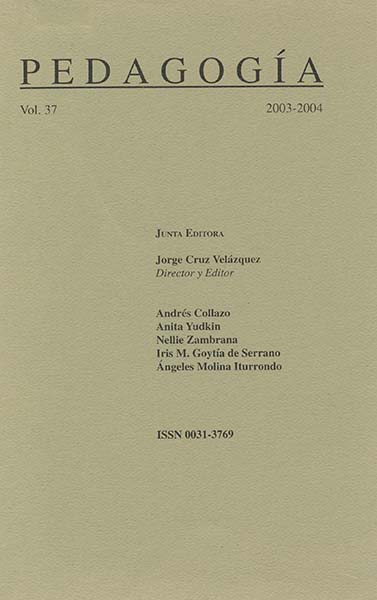Resumen
Cómo citar:
Arce, M., Álvarez, P. & Molina, R. (2004). Contexto cultural y tecnología. Pedagogía, 37(1), 29-38.
Citas
Barraket, J. & Scott, G. (2001, Sept). Virtual equality? Equity and the use of information technology in higher education. Australian Academic &Research Libraries (AARL), 32, 204-212.
Bialo, E. R., Sivin-Kachala, J. (1995). Report on the effectiveness of technology in schools, '95- '96. Washington, D.C.: Software Publishers Assn.
Brown, M. (2001). The digital divide. Leaming and Leading with Technology, 28, 10-20.
Cambre, M. & Hawkes, M. (2001). Educational technology: Identifying the effects. Reston, 1, 48-51.
Coley, R., Cradler, J., Engel, P. K. (1997). Computers and classrooms: The status of Technology in U. S. schools policy and information report. Educational Testing Service, 71 p.
Eisenberg, M. B. & Johnson, D. (1996). Computer skills for information Problem solving: Learning and teaching technology in context. ERIC Clearing-house on Information and Technology Publications, EDO-IR-96-04. March. [On-Line] Available: http://ericit.org/digests/EDO-IR-l 996-04.shtml
Glanz, J. (1998). Action research: An educational leader 's guide to school improvement. Norwood, MA: Christopher-Gordon Publishers, Inc.
Kennedy, P. (2001, Dec). The electronic gap. UNESCO Courier, 48.
Mills, G. E. (2000). Action research: A guide for the teacher researcher. Upper Saddle, NJ: Prentice Hall, Inc.
Morahan-Martin. (1998). Women and girls last: Females and the internet. IRISS '98: Conference Papers International Conference: 25-27 March 1998, Bristol, UK.
Pearson, T. & Swain, C. (2001). Bridging the digital divide: A building block for teachers. Learning and Leading with Technology, 28, 10-16.
Reiter, D. (2002). Your child and computer literacy. [On-Line] Available: http://learningvillage.com/htmlartreiter.html http:/ /www.hands.on.ca
Spradley, J. (1980). Participant observation. Fortworth, TX: Harcourt Brace. United States Government. (2000). Rural areas magnify "digital divide". Fact Sheet. [Online] Available: http://www.ntia.doc.gov/ntiahome/digitaldivide/factsheets/rural.htm
University of Minnesota Duluth, United States. [On-Line] Available: http://www.dumn.edu/student/loon/acad/computer/Geneoperation.html, http://www.dumn.edu/student/loon/acad/computer/comlntemet.html
Vygotsky, L. S. (1990). Aspectos conceptuales y teóricos de la psicología de la instrucción. En Genovard & Gotzens (Eds.), Psicología de la Instrucción (pp. 48-49). Madrid: Grafiris Impresores, S. A.
Wolcott, H. F. (1988). Ethnographic research in education. En R. M. Jaeger (Ed.), Complementary methods for research in education. (pp. 187-210). Washington, DC: American Educational Research Association.

Esta obra está bajo una licencia internacional Creative Commons Atribución-NoComercial 4.0.

